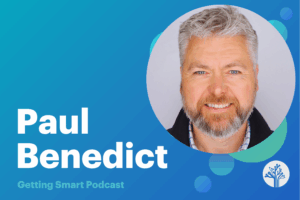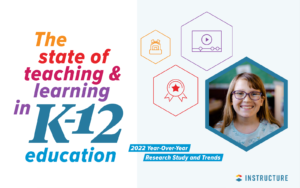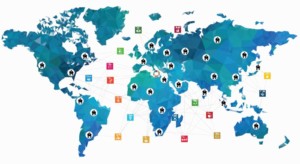The Common Core of the Student Needs the Common Core of Place

By Nate McClennen & Milton Chen
In the aftermath of a contentious election which divided the nation, it is time to reflect on what connects us together rather than keeps us apart. And more importantly, what can bring us together and heal the divides that threaten to disrupt key elements that we as educators strive for in our graduates – kindness, collaboration, empathy, and thoughtful and well-informed discourse.
One silver lining amidst these noisy and unprecedented divides may be a fundamental re-consideration of the purpose of education, which could forestall the mere retreading of the policies and systems of the past. What should education look like in 2018 and beyond? Where and how should it be provided? And by whom? In addition to their teachers, in an age of rapidly exploding knowledge, today’s students need to learn from many experts and mentors.
Much of the past decade of education reform has focused on the passage of the Common Core State Standards (CCSS), adopted by close to 40 states, with others considering their own standards as well. These extensive policy discussions at the federal, state and local levels attempted to answer the question, “What should children learn?” We wish these experts had also asked, “What do children need? Why should they care about what the standards require them to learn? What about the ‘Common Core’ of the child – the personalized approach?”
Hope, however, is emerging. In the midst of the continue loud machinations of our industrial-era model of education, there are voices starting to talk in unison about personalization and application – the antithesis of uniformity and regurgitation. While the descriptors vary with terms such as deeper learning, project-based learning, STEAM education, maker mindsets, and mastery-based education, there is an indisputable commonality based on the common core of the child. So what does this look like in practice and what is missing?
Part of that answer would be parental and family support for learning. Research has repeatedly shown how educated parents are the strongest predictors of educated children. Parents who understand that education is the key to their children’s success talk positively and read frequently to their children at a young age and advocate for the best schools and teachers for them. We applaud efforts by early childhood programs and schools to reach out to parents and help them become “a child’s first and most important teacher.” These efforts should start early, in the 0-5 years, to develop the social and emotional learning (SEL) muscles of children that can be strengthened further by SEL programs in schools.
Another part of that answer would include an expansive set of knowledge and skills that can become a universal toolkit for students that can be carried through college and adulthood. While acknowledging that the CCSS call for connecting English/language arts and math to other subject areas, we also believe that the study of STEM, history, culture, arts, and civics should be granted equal footing and should be much more fully integrated.
However, this personalized approach, the Common Core of the Child, is not sufficient to push us forward and up. Standards address the “what” of education. What’s missing is the “where.” And therein lies the key to standards and curriculum integration. Richer, deeper, and ultimately more personal and meaningful learning cannot be successful within the four walls of the classroom. Students need to personalize and make relevant their learning in many other places, where they can encounter real issues and the professionals working in them: in city, state and national parks; historical sites; businesses; factories; museums; and libraries. The Common Core of the Child needs to learn through the “Common Core of Place.”
If place-based learning seems like a radical idea, remember that this is how children learned in earlier agrarian times – and throughout the history of informal education. The “Common Core” of the 19th century naturally led children to prepare for their future lives by working alongside their parents, siblings, friends and neighbors on real-world projects such as tending crops, making tools, caring for animals, transporting goods and preparing meals. We advocate for a modern brand of this type of authentic learning, tied to real tasks of value to families and communities which develop skills through master-apprentice relationships. The modern version of this applies interdisciplinary projects to K-12 education with the intent of understanding “what is” and “what could be.” With students repeatedly asking these questions about their communities – and actively designing solutions for the community – we build the Common Core of the Child grounded in the Common Core of Place.
In our work, both nationally and internationally, we see countless examples of this happening. Elementary students learn about water quality and engage in design thinking to create prototype water filters. Middle school students study their local forest and develop a tree identification key based on bark types. High school students investigate the impact of invasive species on local warm springs, learn fly fishing, paint watercolors of flies, and debate the impact of dam removal on the watersheds of the Snake and Columbia Rivers. Students start their own businesses, support the movement of legislation, and generally personalize their learning to positively impact local and global places.
By addressing complex local issues through project-based learning, such as air and water quality or traffic congestion, students conduct real science connected to public policy. They learn to ask good questions, form hypotheses, collect and evaluate data, make conclusions, and share their knowledge with peers and adults. Using design thinking principles, students often come up with solutions that can involve new products and services for companies, nonprofits and government agencies. They also learn invaluable lessons about persistence and turning failures into improvements.
In today’s world, learning in significant places in a student’s community creates immediate connections to larger issues in their state, our nation, and the world. It is the best way to actualize the ideal of “acting locally, thinking globally.” Through the Common Core of Place, students understand that every community on Earth is comprised of social, ecological and economic building blocks. They see how collaboration, interaction, and debate among community leaders and members affects the health and vitality of these places.
Importantly, learning through the Common Core of Place propels students towards becoming active citizens, showing them that change is possible and that initiative and creativity are critical. This style of learning is our best hope for combating the dropout rate, declining volunteerism, and low voting rates among our youth, and our best hope for unifying the nation around long-term economic, social and ecological sustainability.
Perhaps most importantly, we understand that by learning in authentic places, students also learn more deeply about themselves. We have seen students compare threats to ecosystems to the challenges they face in their own personal and family lives. In witnessing the recovery of endangered species, they discover their own wellsprings of resilience and compassion for others.
As our nation enters a period of educational transformation at the same time of significant cultural divisiveness, let’s look beyond the classroom to the many learning places in our communities. The people, places and organizations that represent a broad spectrum of beliefs, skills and opportunities. Collectively, they represent our country – each is a small microcosm of the world. Let’s dream of a future where learners discover with their own eyes the truths they can act on within their own places, rather than the truths of whatever media bubble they live. This personal and local approach – a Common Core of Place – which has deep roots in our nation’s history offers our best chance to strengthen our nation and, in the words of our Constitution, “form a more perfect union.”
For more on Place-Based Education, see:
- What is Place-Based Education and Why Does it Matter?
- 21 Tips for Connecting Learners to their Communities
- Students Share their Perspectives on Place-Based Learning
Nate McClennen is Vice-President of Education and Innovation at Teton Science Schools. Follow them on Twitter: @tetonscience
Milton Chen is the Chair of the Education Committee of the National Park System Advisory Board. Follow him on Twitter: @miltonchen2
Stay in-the-know with all things EdTech and innovations in learning by signing up to receive the weekly Smart Update.






0 Comments
Leave a Comment
Your email address will not be published. All fields are required.